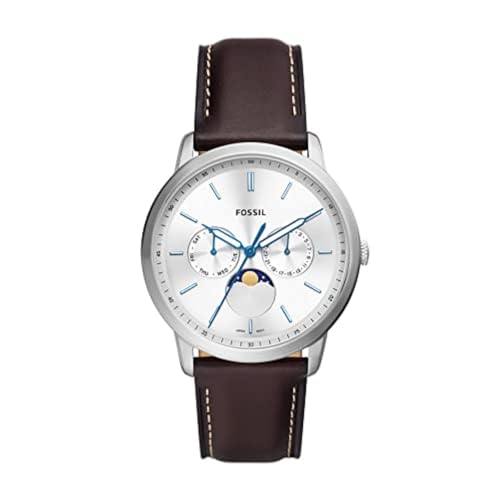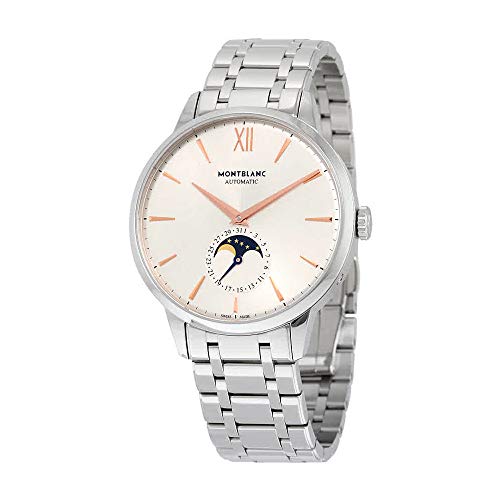Have you ever gazed up at the night sky, marveling at the beauty and mystery of the moon? Imagine being able to carry a piece of that celestial wonder on your wrist. Moonphase watches offer a captivating blend of timeless elegance and astronomical precision. Whether you are an avid watch collector or simply appreciate the artistry of a well-crafted timepiece, this blog post will take you on a journey through the enchanting world of moonphase watches. From their origins to the intricate mechanisms that power them, we will delve into the fascinating world of these celestial companions. So, sit back, relax, and join us as we explore the captivating allure of moonphase watches.
Top picks for elegant and functional moonphase watches
History of Moonphase Watches
Moonphase watches have a long and fascinating history, dating back to the 17th century. These timepieces were not only functional, but also a remarkable display of craftsmanship and artistic design. In this blog section, we will delve into the origins of moonphase watches, explore how they evolved over time, and understand why they became such a popular feature in luxury watches today.
Origins of Moonphase Watches
The concept of showcasing the moon’s phases on a timepiece began with the development of astronomical watches. In the early 1600s, astronomers and watchmakers worked together to create a mechanism that could accurately display the moon’s phases. This was done by incorporating a rotating disk with a representation of the moon on the dial of the watch.
One of the earliest known examples of a moonphase watch is the timepiece made by the Swiss watchmaker, Louis Recordon, in 1800. This watch featured a moving moon disk and accurately displayed the different phases of the moon. It was a significant achievement for its time and set the stage for future advancements in moonphase watches.
Evolution of Moonphase Watches
As technology advanced, so did the complexity and precision of moonphase watches. In the 19th century, watchmakers began incorporating additional complications, such as perpetual calendars, into moonphase watches. These timepieces not only displayed the moon’s phases but also provided information about the date, month, and even leap years.
The 20th century saw further advancements in moonphase watches. Watchmakers developed more accurate and efficient mechanisms for displaying the moon’s phases. Additionally, designs became more intricate and aesthetically pleasing, often featuring stunning enamel dials or intricate engravings.
Popularity of Moonphase Watches
Moonphase watches have always been associated with luxury and sophistication. Their intricate mechanisms and artistic designs make them highly desirable among watch enthusiasts and collectors. Here are key reasons why moonphase watches have become so popular:
- Aesthetics: Moonphase watches offer a unique and captivating visual display on the dial, adding an element of elegance and charm to the timepiece.
- Horological Tradition: Moonphase watches have a deep-rooted history in horological craftsmanship, which appeals to those who appreciate tradition and the intricacies of mechanical watchmaking.
- Convenience and Practicality: Moonphase watches with perpetual calendars provide not only an accurate display of the moon’s phases but also incorporate useful calendar functions, eliminating the need for manual adjustment.
- Exclusivity: Moonphase watches are often produced in limited quantities, making them highly sought-after and exclusive collector’s items.
Benefits of Moonphase Watches
Moonphase watches offer more than just a visually appealing feature. They provide practical benefits that enhance the overall watch-wearing experience. Here are several advantages:
- Accurate Tracking: Moonphase watches can accurately track the phases of the moon, allowing wearers to stay connected to celestial events.
- Versatility: Moonphase watches can be incorporated into various watch styles, ranging from classic dress watches to sporty timepieces.
- Conversation Starter: The unique feature of a moonphase watch is an excellent conversation starter and creates a sense of intrigue and fascination with those who appreciate horological art.
In conclusion, moonphase watches showcase a perfect blend of functionality, craftsmanship, and artistic design. They have a rich history dating back centuries and have evolved into highly desirable luxury timepieces. So, whether you are a watch enthusiast, collector, or simply appreciate the beauty of celestial mechanics, a moonphase watch is a breathtaking addition to any collection.
Images: Louis Recordon’s Moonphase Watch, Moonphase Watch
Functionality of Moonphase Watches
Moonphase watches are fascinating timepieces that incorporate an additional complication to track the phases of the moon. Not only do they add a touch of elegance to your wrist, but they also provide a practical and aesthetically pleasing function. In this blog post, we will explore how moonphase watches work, the mechanics behind their accuracy, and the different types of moonphase displays along with their advantages and limitations.
How Moonphase Watches Work
A moonphase watch consists of several components that work together to accurately display the current phase of the moon. The main elements include:
- Moonphase Disk: The moonphase disk is a small disc within the watch that depicts a complete lunar cycle. It typically shows the full moon, new moon, and varying stages in between.
- Lunar Module: This module is responsible for translating the rotational movement of the watch’s hour wheel into the progression of the moonphase disk. It ensures that the moonphase display accurately corresponds to the actual phase of the moon.
- Gearing: The gears within the watch engage with the lunar module, allowing it to move the moonphase disk. The gearing is carefully calibrated to ensure precise and accurate movement of the moonphase display.
The Mechanics of Accuracy
Moonphase watches are designed to be accurate, but how do they maintain this accuracy over time? The key lies in their complex mechanical movement. Here’s how it works:
- Lunar Cycle: The average lunar cycle lasts approximately 29.5 days, but for simplicity, most moonphase watches are designed to follow a 59-tooth wheel. This wheel corresponds to two lunar cycles of 29.5 days each.
- Adjustments: To compensate for the slight discrepancy between the actual lunar cycle and the 59-tooth wheel, moonphase watches require occasional adjustments. Manufacturers often recommend setting the watch every two to three years to ensure precise tracking of the moon’s phases.
- Accuracy Limitations: Despite their accuracy, moonphase watches may still deviate from the actual lunar cycle due to slight variations in the watch’s mechanical parts or adjustments made during manufacturing. These deviations are minimal and hardly noticeable in day-to-day use.
Types of Moonphase Displays
Moonphase displays come in different designs, each with its own unique advantages and limitations. Let’s explore some popular types:
- Subdial Moonphase: This type of display features a small subdial on the watch face dedicated solely to showcasing the moon’s phase. It is elegant and doesn’t compromise the main dial’s readability. However, the small size of the subdial may make it a bit challenging to read at a glance.
- Aperture Moonphase: In an aperture moonphase display, a portion of the dial is cut out to reveal a rotating disc underneath that depicts the moon’s phase. This design allows for larger and more detailed moonphase indications, making it easier to read but might slightly affect the overall aesthetics of the watch.
- Digital Moonphase: Some modern moonphase watches integrate digital displays to represent the lunar cycle. These timepieces often combine traditional analog hands with digital screens, offering a clear and precise moonphase display without compromising on readability or aesthetics.
Key Points
To summarize, here are some key points to remember about moonphase watches:
- Moonphase watches have an additional complication to track the phases of the moon.
- They consist of a moonphase disk, lunar module, and precise gearing.
- Moonphase watches maintain accuracy through mechanical movements and occasional adjustments.
- Different types of displays include subdials, apertures, and digital screens.
- Each type of display has its advantages and limitations in terms of readability and aesthetics.
Moonphase watches offer a unique blend of functionality and timeless beauty. Whether you are an astronomy enthusiast or simply appreciate the artistry of watchmaking, a moonphase timepiece is a remarkable addition to any collection.
Popular Moonphase Watch Models
Moonphase watches have always held a special allure for watch enthusiasts and collectors. The mesmerizing display of the moon’s phases adds a touch of elegance and sophistication to any timepiece. Today, we will explore some of the most iconic moonphase watch models from renowned watchmakers, each with its unique features, design, and price range.
Rolex Cellini Moonphase
Rolex is a brand known for its exceptional craftsmanship and timeless designs. The Rolex Cellini Moonphase is no exception, combining exquisite aesthetics with precision timekeeping. Here’s what sets it apart:
- Design: The Cellini Moonphase features a classic round case, available in 18k Everose gold. The dial showcases an enchanting blue enamel moon disc, with a full moon represented by a meteorite applique. The hour markers and hands are crafted from 18k Everose gold.
- Movement: Powered by Rolex’s in-house automatic caliber 3195, the watch boasts impressive accuracy and reliability. The movement also features a moonphase module, providing a moon cycle display with an accuracy of 122 years.
- Price Range: The Rolex Cellini Moonphase is a luxurious timepiece with a price range starting from $26,750.
Patek Philippe Calatrava Ref. 7121G-001
Patek Philippe is renowned for creating some of the world’s most prestigious watches, and the Calatrava Ref. 7121G-001 is no exception. This model delivers elegance and sophistication with a touch of vintage charm:
- Design: The Calatrava Ref. 7121G-001 features an elegant and slim 33mm white gold case, adorned with shimmering diamonds on the bezel. The dial showcases a moonphase display with a beautiful blue background, adorned with golden stars and a golden moon.
- Movement: Powered by the Patek Philippe Caliber 215 PS LU, the watch offers impeccable timekeeping accuracy. The moonphase mechanism only requires adjustment once every 122 years.
- Price Range: Patek Philippe watches are esteemed for their exclusivity, and the Calatrava Ref. 7121G-001 falls into a higher price range, starting at $36,700.
Omega Speedmaster Moonphase Chronograph
Omega, known for its association with space exploration, offers the Speedmaster Moonphase Chronograph as a tribute to the iconic Speedmaster Professional. Here’s what makes it stand out:
- Design: The Speedmaster Moonphase Chronograph features a 44.25mm stainless steel case with a distinctive blue dial. The moonphase display occupies a sub-dial at 6 o’clock, displaying a detailed image of the moon’s surface. The watch also includes a date and chronograph function.
- Movement: Equipped with the Omega Co-Axial Master Chronometer Caliber 9904, this watch offers exceptional accuracy, antimagnetic properties, and a power reserve of 60 hours.
- Price Range: The Omega Speedmaster Moonphase Chronograph offers excellent value for money, with a price range starting at $9,600.
Moonphase Watch Comparison
To summarize the key details and benefits of these popular moonphase watch models, here’s a comparison table:
| Watch Model | Design | Movement | Price Range |
|---|---|---|---|
| Rolex Cellini Moonphase | Classic round case, blue enamel moon disc | Rolex in-house caliber 3195, 122-year moonphase accuracy | Starting at $26,750 |
| Patek Philippe Calatrava | Slim white gold case, diamond bezel | Patek Philippe Caliber 215 PS LU, 122-year moonphase accuracy | Starting at $36,700 |
| Omega Speedmaster Moonphase | Stainless steel case, detailed moonphase dial | Omega Co-Axial Caliber 9904, antimagnetic | Starting at $9,600 |
Each of these moonphase watch models brings its unique blend of design, craftsmanship, and complications. Depending on your style and budget, these timepieces offer a statement of elegance and fascination. Whether you choose the timeless appeal of Rolex, the prestige of Patek Philippe, or the heritage of Omega, a moonphase watch is sure to captivate and inspire for generations to come.
The Final Word on Moonphase Watches
In conclusion, moonphase watches are a fusion of beauty and functionality that will surely delight watch lovers. They provide a unique way to appreciate the art of timekeeping while offering a practical tool for tracking lunar phases. To ensure the perfect choice, one should take into account their personal preferences, budget, and desired features. With careful consideration, a moonphase watch can become a cherished timepiece for years to come.












